LOST 020 - Don't Mistake Coincidence For Fate
Is there an Eko in here? Is there an Eko in here? Unpacking the TV show LOST — Season 2: Episodes 8-10
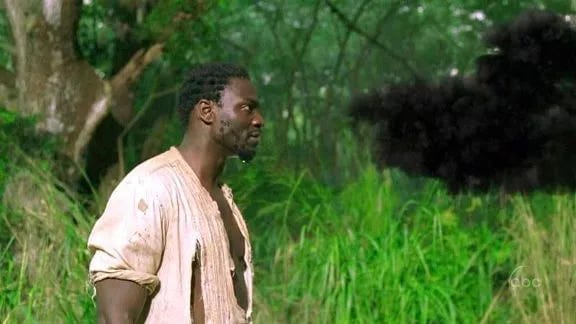
Another fortnight has gone by, and so it comes to pass that another three 15-year old episodes of a TV show get way more attention than anyone should ever have expected.
Previously, on LOST: Oceanic 815 broke in two pieces and crashed (these two things might be related), and there were survivors, most of whom have become (mostly) friends all doing their best to stay alive on an island of mystery. Now they’re in an underground bunker, entering a sequence of numbers to save the world, as far as any of them know. They’ve just been joined by another group of survivors, who had been in the tail part of the plane, and one of the Tailies—named Ana Lucia—shot one of the (mostly) friends, whose name was Shannon, and whose days of trying to stay alive on an island of mystery have unfortunately come to a rather sudden end.
O B S E R V A T I O N
Before we dig into the episodes, I want to take a moment to appreciate the Tailies. I have a rudimentary recollection that this narrative gambit was seen as a bit of a failure—perhaps due to the fact that (spoilers) there were alleged issues with the actors of one kind or another, and as a result (spoilers) these folks are around for a good time, but not for a long time. And it’s unfortunate, really. These are all fascinating characters, well-acted all around, and would have in my opinion made excellent additions to the narrative long game.1
Anyway, we’re going to get a good look at them in this installment, and we ought to appreciate it while we can, because we aren’t going to get very many more.
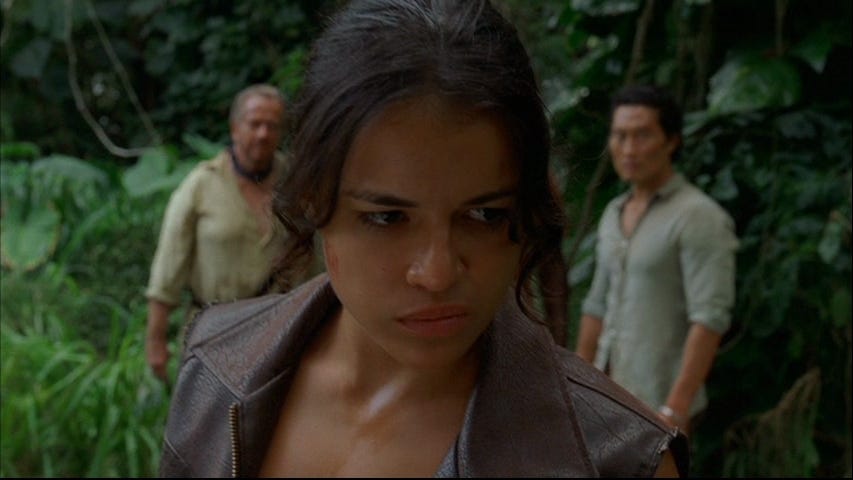
Episode 8: COLLISION (Ana Lucia): The episode-long flashback is over; we’re all caught up on the Tailies. We begin exactly where we left off: in the rain,2 with Sayid cradling his lover’s body and looking with murderous intent at a stranger whose gun just fired its last bullet. Sayid draws his gun and advances. Eko tackles him.
There’s a lot of mud-fighting but in the end Ana winds up getting Sayid’s gun. She was already fully paranoid even before she killed somebody, and now she goes full Kurtz, holding both the Oceanic strangers and her Tail-section friends hostage, while she tries to figure a way out of her predicament. Eko, with his typical quiet resolve, simply and firmly refuses her commands, and carries the gravely ill Sawyer away in the direction of the island’s only doctor, leaving Ana Lucia to clean up her mess without her main ally.
This showdown makes up the bulk of the episode, as one by one various hostages—Michael, Jin, Libby, Bernard, and eventually even Sayid—either leaves Ana Lucia despite her threats, or is permitted to depart, leaving her more and more isolated and desperate.3
As this drama unfolds, we receive Ana Lucia’s backstory: she’s an LA cop who suffered a near-fatal shooting in an unguarded moment, and who now is quite understandably psychologically traumatized and paranoid. Less understandably, she still wants to carry a gun and drive a beat, even though she’s clearly psychologically unfit and far too eager to draw her weapon. More understandably but far less legally, she also has dispensed some premeditated vigilante justice to her assailant, executing him in cold blood—but not before revealing that she had been pregnant when he shot her. So we have yet another character who has murder in their backstory,4 and we are not even close to done adding to that number today.
This backstory stuff provides vital information about what has been motivating the strong, driven, brave, but severely authoritarian and paranoiac woman at the center of the plot these last several episodes—and also explains why the abduction of the children in particular was a breaking point for her, albeit in a way that leans on some lazy “women go baby crazy” tropes I don’t love. In the end, she attempts to commit suicide-by-Sayid, but Sayid declines the opportunity for revenge, recognizing that she is already living in her punishment.
Meanwhile: Eko brings Sawyer to Jack and the Swan station crew, and single-handedly defuses an escalating situation by remaining completely and calmly uncooperative no matter how agitated Jack in particular becomes about where all of his friends are being held captive. Easily my favorite part of this episode (and it’s a good episode) is Adewale Akinnuoye-Agbaje’s work here, as Eko quickly and quietly assesses the bunker, sees the rack of guns, does the math, and makes up his mind—then effortlessly takes control of the entire scenario simply by refusing to react. Adewale Akinnuoye-Agbaje’s work is usually my favorite part of anything that Adewale Akinnuoye-Agbaje appears in, and Eko is pretty much my favorite part of any episode that has Eko in it, so my preferences here should perhaps not be surprising.
In the end, Eko agrees to bring Jack to the hostages if he comes alone without weapons, and Jack agrees—but by the time he gets there, the situation is resolved, and it’s just him and Ana Lucia alone, in a somewhat more awkward situation than their flirty introduction over drinks at the airport bar, a world away, a lifetime ago.
Tailies and Rafties make it home! There is a big emotional reunion on the beach: Jin and Sun, Rose and Bernard, Michael and Vincent. People who love each other, coming together after separation—this is the very lifeblood of LOST.5
Aw.
End of Episode 8.
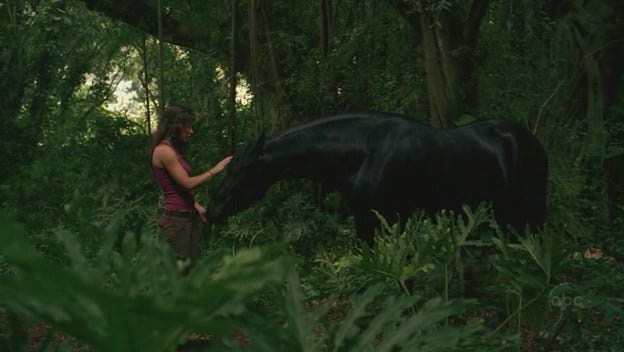
Episode 9: WHAT KATE DID (Kate) Speaking of people who love each other coming together after separation, Sawyer is back with a septic gunshot wound, and Jack Of Course is taking care of him. Also Kate is there, which means the three of them are all going to have to work out which two among the three of them kisses first.
This turns out to be Kate and Jack, partially because Sawyer is still comatose, but mostly because Kate has it bad for Sawyer and is disassociating. Why? Because she can’t handle how much Sawyer reminds her of her dirtbag stepfather, Wayne. Wayne is the focus of this week’s flashback, by the way. Let me tell you about Wayne. Wayne is a drunken dipshit and domestic violence aficionado for whom Kate’s waitress mother left Kate’s loving, straight-arrow, military recruiter father. Wayne beat Kate’s mom on the regular we discover, and it’s heavily implied he might also have been casting a none-too-appropriate eye and occasional grab Kate’s way. Honestly? As presented, he’s not much like the charming rakish con-man Sawyer, but I guess both of them are low-class so sure OK whatever.
Anyhoo, one fine night Kate fried Wayne’s green tomatoes by leaving his gas stove on, then waiting until he came home shitfaced, putting him passed-out in his bed next to her lit Zippo, then driving off on her motorcycle until hadouken fireball BOOM. Goodbye, Earl. Problem is, Kate’s mom loved Wayne. So mom turned Kate in, and that’s why Kate has been on the run lo these many incoherent flashbacks.
So there you go. That’s what Kate did. This part of Kate’s story actually makes perfect sense, which is refreshing, even if it’s such standard narrative fare that I could make two easy references to famous uses of this trope.
And there’s another murderer among our heroes. Take a drink.
Back to the island. Kate is seeing a horse. (Yes, that’s right, a horse. A god-damned horsie. Don’t you dare leave me now.) As a result, she thinks she’s going crazy. Not because it’s a horse on a jungle island—after all, this particular jungle island has ghost whispers and hatches and monsters and polar bears and disappearing reappearing Drippin’ Wet Walt on it—but because Kate is pretty sure it’s the exact horse that helped her escape the police’s clutches (long story), and she’s also pretty sure that the horse holds the spirit of the man she murdered—Wayne, her father.
Oh yeah, it turns out that Ol’ Exploding Wayne is Kate’s real father. She didn’t kill him because he beat Kate’s mom; she killed him because she found out the truth and couldn’t bear knowing that he was a part of her. Again, this is why her attraction to Sawyer led her to overcompensate via jungle kissyface with a now very confused Jack.
In conclusion, Kate is a land of contrasts.
Sawyer eventually recovers, Kate leads him out of the Swan into the jungle where they see the horse, and Kate … look, this is weird, but she makes peace with the horse. I’m not here to tell you every part of this show works.
At the Swan: Jin gets his handcuff cut off his wrist, to his (and presumably Daniel Dae Kim’s) great relief. And Michael gets a gander at the Swan station and notices some blast doors that will probably be relevant soon. It makes sense that Michael would be the one to draw attention to the doors, because he is a builder and has an eye for structure; nice bit of character continuity, that.
Eko reveals to Locke that, at the abandoned storage Dharma bunker the Tailies used as base camp, he found some of the missing footage that has been cut from the Swan training video. Locke splices it in, and we get a deleted scene of Dr. Marvin Candle warning Swanies to NEVER use the entry computer for ANYTHING other than entering the numerical sequence every 108 minutes. He repeats it maybe 5 times, oh my God it is so so important you guys. Locke marvels at the fate that brought Eko and his deleted scene to Locke and his training video; in response Eko says the line I chose for the title of this newsletter entry.
As Eko and Locke watch this warning to not use the entry computer for anything else, we see that unbeknownst to them, Michael is using the entry computer to play Solitaire. No, I’m kidding; he’s using it as a sort of rudimentary instant message device.
WHO ARE YOU asks the unknown party on the other end.
MICHAEL, replies Michael, so points to him for honestly.
DAD? comes the reply.
Cue Michael’s shocked face.
End of Episode 9
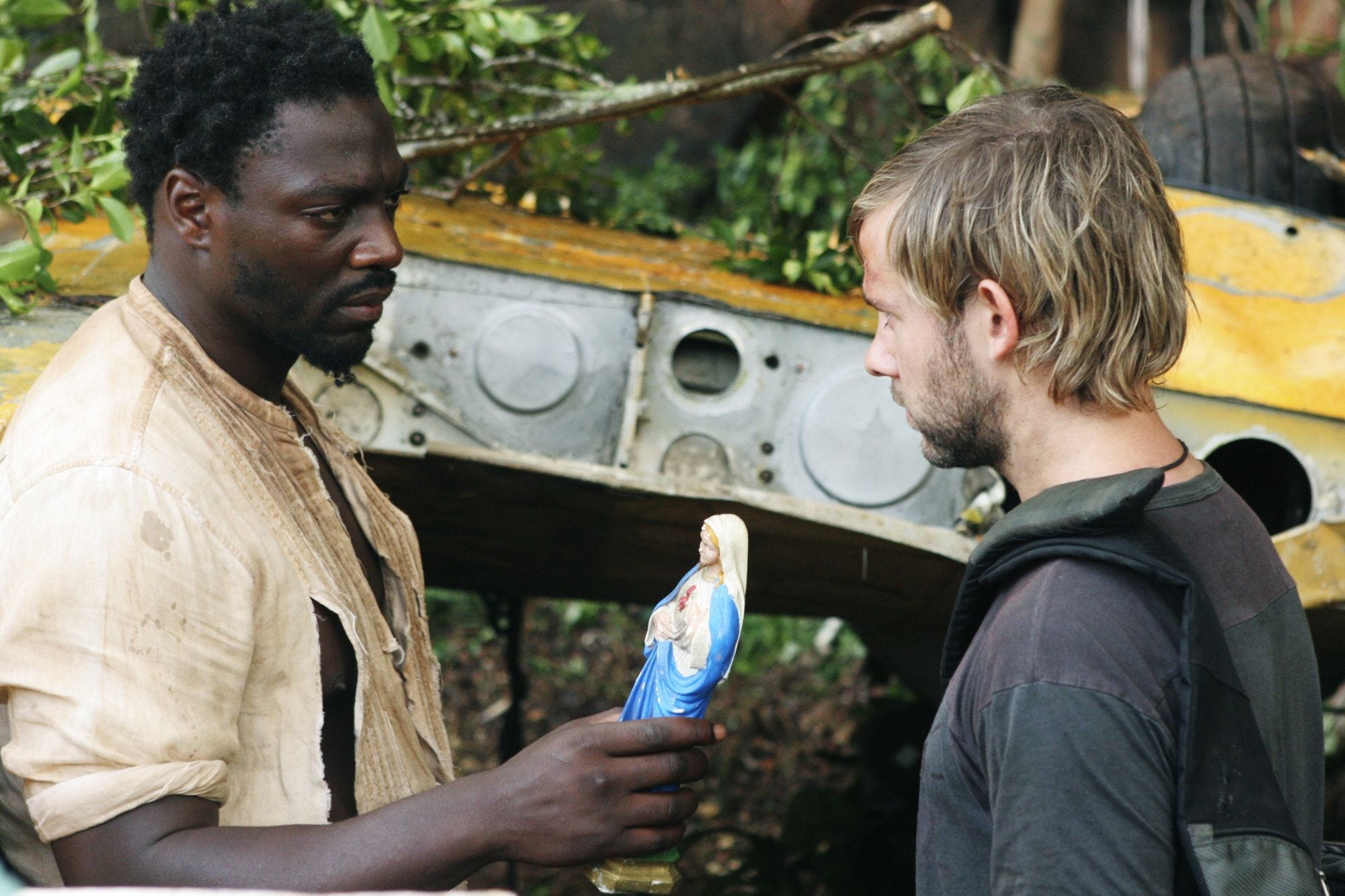
Episode 10: THE 23rd PSALM (Eko). On the beach, Claire gets to talking with Eko, because she is a friendly lady. For several episodes, we've received clues that Eko is a deeply religious man, and we receive another here, as Eko discusses the Biblical character of Aaron, who shares a name with Claire's baby. The religious talk leads to Claire mentioning that Charlie has a statue of the Virgin Mary—the statue we and Charlie and Sayid know (but which most others don’t know) came from the Beechcraft where Boone died, and contains a lot of heroin. This alarms Eko greatly for reasons he won’t explain, but he clearly knows that the statue contains heroin, because he breaks it open in front of Charlie and a shocked Claire, then drags Charlie out into the jungle to show him where he found it.6
In flashbacks we soon learn why Eko is so consumed: in a previous life this clearly dangerous but deliberately peaceful man was a murderous (take a drink) Nigerian warlord, conscripted into the criminal militias as a child—a fate that he took upon himself to spare his younger brother, Yemi. In adulthood, Yemi has become a priest, and the notorious Mister Eko returns to pressure him for assistance in his current scheme; he and his gang intend to pose as priests to transport a large shipment of heroin out of the country, hidden inside icons of Mary, on a flight disguised as a relief mission. Yemi alerted the military but ran ahead to warn Eko and got shot in the resulting melee. Eko’s colleagues abandoned him on the tarmac, and Eko, mistaken for his brother by the military, has been posing as a priest ever since. The last time he saw his brother, Yemi was bleeding to death, bundled into a Beechcraft plane full of statues just like the one he’s now holding.
Whew.
Anyway, this flashback is very cool in the way it ties the origins of the Beechcraft back to the story in a surprising way, even if it’s sort of disappointing that the flashback relies on tired-ass warlord tropes for the series’ most prominent African character—but since I’ve complained about tired-ass tropes in all 3 backstories so far, I think we’ll have to accept that this is a tropey show sometimes, especially as the flashback structure starts to wear thin.
Charlie as we’ll soon learn clearly knows exactly where the Beechcraft is, but is being cagey in the way of addicts when it comes to drugs. Eko calls him out. “Take me to the plane,” he insists, and Charlie wisely doesn’t play dumb and take him to the Oceanic cabin. They head toward the Beechcraft where Boone died.
They come upon a body from the plane; it’s one of Eko’s fellow gangsters, disguised as a priest. Charlie pretends to be unsure of where the plane is. Suddenly agitated, Eko insists Charlie climb a nearby tree—ostensibly so Charlie can see if he can get his bearings … but watch it and tell me if you don’t see that Akinnuoye-Agbaje is playing it as if Eko senses something is coming.
And something is coming. It’s the monster, and we (and Charlie, perched in a tree) see it for the first time. It’s a mass of black smoke, or maybe a stormcloud if you ask some people, by which I mean me. It comes right up to Eko’s face, and Eko stares it down until it retreats, and 15-year-old TV CGI aside, it’s fuckin’ awesome.
Charlie and Eko make their way to the airplane. Yemi’s desiccated body is inside. Eko weeps and begs forgiveness, then takes the crucifix from Yemi’s neck and puts it on; it’s the cross he was wearing as a child, which was torn off of him when he was conscripted into the militia so many years before. “Are you a priest?” Charlie asks. “Yes, I am,” Eko says. Chills.
Eko burns the Beechcraft, and recites the 23rd Psalm over his brother’s funeral pyre. Charlie joins in.
Eko gives Charlie an icon to replace the broken one.
Later, Charlie tries to convince Claire that he’s not an addict anymore, but she won’t hear him; she wants him to stay away from her. We see Charlie place his replacement Heroin Mary in a hidden cache … filled with Heroin Marys.
It’s not looking great for old Charlie.
End of Episode 10.
B E L I E F
Let’s talk about some of the things we’ve observed, and what I believe about them.
1) The Beechcraft: So a tiny propeller plane takes off from Nigeria and somehow lands on an island in the Pacific Ocean? How?
I’ve answered this before, but this is just another proof point for it: The island isn’t in the Pacific—not always, anyway. The island is moving in a very low orbit around the planet Earth.
How low?
I believe low enough that at times it can intercept low-flying airliners like Oceanic 815, and other times even lower than that; low enough that you need a submarine to intercept it. Underwater, in other words.
Underwater? How could that be?
Let’s save that question for another time, but let’s keep an eye out for a submarine. Maybe one will turn up!
2) The Computer: OK, so this spliced bit of the training video Eko found that warns DO NOT USE THE COMPUTER FOR ANYTHING ELSE doesn’t really turn out to matter; it’s there just to give us viewers a sense of foreboding when we see Michael use the computer, perhaps to alert us to something we ought to already have pretty well figured out—which is that Michael’s not really in an online chatty room with his son, but is being catfished by the Others. I want to circle back to it to point out that this is our first clear indication that the Dharma-facility faction of the Others are aware of the Swan station, and are able to monitor it.
There will be other indicators.
Also, Eko introduces this ultimately inconsequential video clip to Locke via a long Bible story about Josiah King of Judah (deep cut, Mister Eko) and the scene is extraneous in the extreme but is also totally bitchin’ because it’s being delivered to such a compelling actor by an equally compelling actor.
3) The Rain: Shannon’s death and the subsequent almost-death of Ana Lucia or Sayid etc. is another example of a downpour hitting just as things turn violent and ghost-whispery, and another example of why I believe one power The Adversary possesses is weather manipulation—either caused deliberately by his will, or involuntarily by his rage.
I also believe Its body may not actually be smoke, but a cloud—specifically a storm cloud (note the electricity crackling inside this smoke). And this next bit goes deep deep deep into Belief, because I’m relying on a reference of a reference of a reference.
I believe The Adversary’s body used to be not only cloud but also fire. Why? Because we’re clearly meant to be thinking Biblically here, and soon we’ll be meant to think of ancient Egypt. And, in the Biblical book of Exodus, a tribe of itinerant former slaves from Egypt (rather famously) get, ah, well, lost, for 40 years, and when they return, they report being told they were a chosen people, who were led by a pillar of cloud in the day, and a pillar of fire at night.
So I believe that in the world of this story, they were on the island.
I don’t think it much matters if I’m right about those exact particulars, but I do believe it’s important to the buried understory that The Adversary has moved from Its original purpose to what we see today.
What changed? Why did the fire go out?
Let’s save that question for another time.
But here’s a hint.
4) The Horse: OK, so we know that one thing that happens when people are brought to the island is corruption. Specifically, The Adversary methodically and deliberately tries to corrupt human beings, in order to prove Its point in the argument It thinks It is having with The Island about the unworthiness of human beings.
But also, we’ll learn the island is a spiritual nexus. The Island calls people—especially broken people—to itself, and then provides them with opportunities to overcome that brokenness, and to find some sort of resolution with who they have been and what they have been struggling with. We see some people—like Locke—respond to this call enthusiastically, while others—most particularly Jack—resentfully resist it … but it is something that happens. It will happen many other times in this series, and sometimes it will be laid out far more explicitly. And I think that’s a big part of the purpose of The Island … who seems more interested in progress than questions of worthiness.
That’s what’s I believe is happening with Kate here. I think the horse is The Island appearing to Kate in a way only Kate would understand—which she clearly does, instinctively. It’s a lot of burden to put on a horse, and maybe the horse isn’t the most successful way to convey it, but I think this is a massively important aspect of the buried understory to keep in mind if we want to understand what’s happening as we move forward. I’ll also remind you here that Sawyer also believed that an animal held the spirit of the man he murdered. So that’s apparently a thing that people on this island feel compelled to believe for some reason.
Or at least some of the murderers, anyway.
I believe the spirits of deceased human beings are on the island, called to the spiritual nexus at the island’s heart.
How many human spirits?
I’d say all.
All of them.
Yes. That sounds about right to me.
5) The Echo: Another person who we see working through his brokenness in order to make his peace with what he’s done is Eko, and it’s made rather unmissably explicit in his episode.
He’ll have another episode later where it’s laid out even more explicitly than this. But I want to talk about something else regarding Eko, a man of faith, his group’s hunter and tracker, who we have already seen set in counterpoint to the main Oceanic group’s hunter and tracker, the main group’s man of faith, namely John Locke. Much will be made of the parallels between these two men over the upcoming episodes, both by the show and me.
Today I’ll just call out something I’ve mentioned before, something that won’t be revealed for a long time still … and that is that Jacob is not the only person seeking a replacement candidate for himself. The Adversary is looking for a new avatar for Itself: somebody with formidable skill, somebody who will be recognized as a leader, someone who It can manipulate into a secret and undetected death, so that It can assume the candidate’s identity, and in so doing, gain access to, and murder, Jacob.
I’ve already said that believe that The Adversary is grooming John Locke to be that avatar, but I also believe there will come ample evidence that The Adversary is also considering Eko for this role. Moreover, I believe that it considers Eko to be the more formidable and powerful candidate for his purposes, but also sees him as the candidate far less likely to mistake coincidence for fate, the candidate who is far harder to manipulate.
I believe that the meeting between Eko and the Adversary is not the first time these two have encountered one another, and I think if you watch how Akinnuoye-Agbaje plays the scene, you’ll see the actor telling us just this.
I’ll tell you an even more out-of-pocket thing that I believe this narrative will eventually tell us in a very glancing way. I believe that in some of many parallel realities to the one we are watching—a next-door neighbor to it—The Adversary actually does choose Eko. (Oh yeah, in case we forgot, I believe we’re dealing with just one of an almost infinite array of possible realities.)
We are watching one of the many realities where The Adversary chooses John Locke instead of Eko. You might think of John Locke as a constant (to use a concept I just made up and will certainly not come up in this series) of this set of realities, one of which we have been watching.
And I believe that this set of realities is not the primary one for the consciousness that makes up the spirit of Eko. I believe there is another set of realities to which Eko is the constant.
What we see here is just a … well, an echo.
Or an Eko, if you like.
L O S T
Next Time: Good Guy, Bad Guy. I’m The Guy With The Guns
Thank you for reading The Reframe. This post is public so feel free to share it.
A.R. Moxon is the author of The Revisionaries, which is available in most of the usual places, and some of the unusual places, and co-writer of Sugar Maple, a musical fiction podcast from Osiris Media which goes in your ears. He’s got it simple, cuz he’s got a band, and he’s got cymbals in the band.
As many reading these things are most likely aware, a least a couple of them were meant to be a part of the narrative long game, but it didn’t work out that way because of real-world stuff. Alas. Such are the perils of serialized long-form fiction. ↩
For now, let’s remember it was raining at the exact moment that Ana Lucia killed Shannon. I’m going to come back around to it. ↩
I’m going to call out one particular moment here, which is that Libby, when questioning Ana Lucia’s judgment, specifically references her decision to put Nathan in the pit—but if you’ll recall, it was Libby who attempted to put Ana Lucia’s suspicions onto Nathan in the first place. Nothing much else to say, but it’s one of the little reasons why I believe Libby and Nathan were part of competing island-aware factions, as I laid out last time. ↩
By my count, so far we’ve seen: Charlie, Sawyer, Sayid. As I said, there will be many more before we’re finished. ↩
Which is something I might mention again before the series finale. ↩
Locke also knows that Charlie has the statue and that it contains heroin, but he chooses to confront Charlie obliquely about it and otherwise keep it to himself. I’m noting this because I think (for reasons I’ll unpack in this installment) it will be wise to note differences and similarities between Eko and Locke. ↩


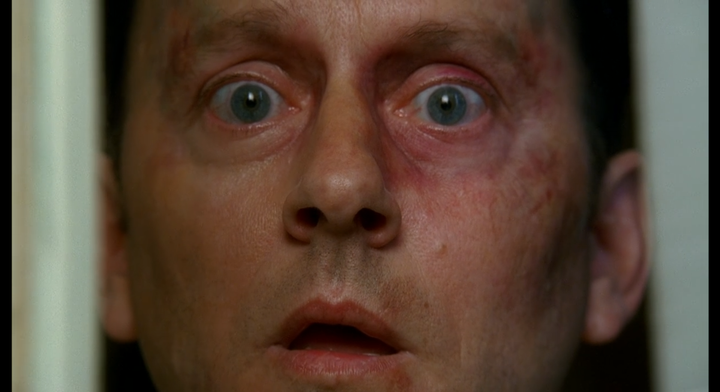

Comments ()